ALSO PUBLISHED IN THE CANADIAN JOURNAL OF FOREST RESEARCH:
Blevins, D.P., C.E. Prescott, H.L. Allen, and T.A. Newsome. 2005. The effects of nutrition and density on growth, foliage biomass, and growth efficiency of high-density, fire-origin lodgepole pine in central British Columbia. Can J. For. Res. 35: 2851–2859.
ABSTRACT
Repression in lodgepole pine is a condition of slow growth in very high-density stands of natural regeneration resulting after wildfire. A factorial thinning and fertilization experiment (two levels of thinning, none and thinned, and two levels of fertilization, none and complete mix) was established on the Chilcotin Plateau in central British Columbia in a 36-year-old repressed lodgepole pine stand. The objectives of this study were to 1) examine the effects of thinning and nutrient addition and their interaction on repressed lodgepole pine tree and stand growth, foliage biomass per hectare, and growth efficiency, and 2) examine these same treatment effects on crown response of foliage and branches at the whole-tree level and by whorl, cohort, and branch order within the crown. Although repression has been considered an irreversible physiological dysfunction, the large increases in growth reported in this study and others indicate that growth of repressed stands was limited primarily by nutrient deficiencies similar to those found in non-repressed lodgepole pine. This suggests that any observed physiological dysfunctions in repressed lodgepole pine are a symptom of repression rather than a cause. Volume growth was increased from 2 to 7 m3/ha/year with nutrient additions on non-thinned plots and to 5 m3/ha/year when fertilizer was applied to thinned plots. Thinning produced a tree-level growth response by allocating limited nutrients to fewer trees resulting in increased tree-level foliage biomass and increased growth efficiency. Additions of nitrogen, sulfur, and boron improved both tree-level growth and stand growth through increases in stand-level foliage biomass and growth efficiency. The additive effects of fertilization and thinning on growth indicate that both treatments are needed to achieve the maximum effect. Increased nutrition and growing space resulted in increases in tree-level foliage biomass, but the mechanisms of these increases differed by treatment. Increased number of fascicles contributed more than increased fascicle weight to the foliage biomass response for all treatments. Increases in the number of foliated branches was more important than increases in the amount of foliage on a branch when fertilizer was applied but these mechanisms were almost equally important to the increase in foliage biomass due to thinning. The lack of treatment effects on foliage biomass at the bottom of the live crown, the position of the bottom of the live crown, and the reduction in the number of cohorts toward the base of the live crown, all suggest that greater foliage biomass response is possible. |

